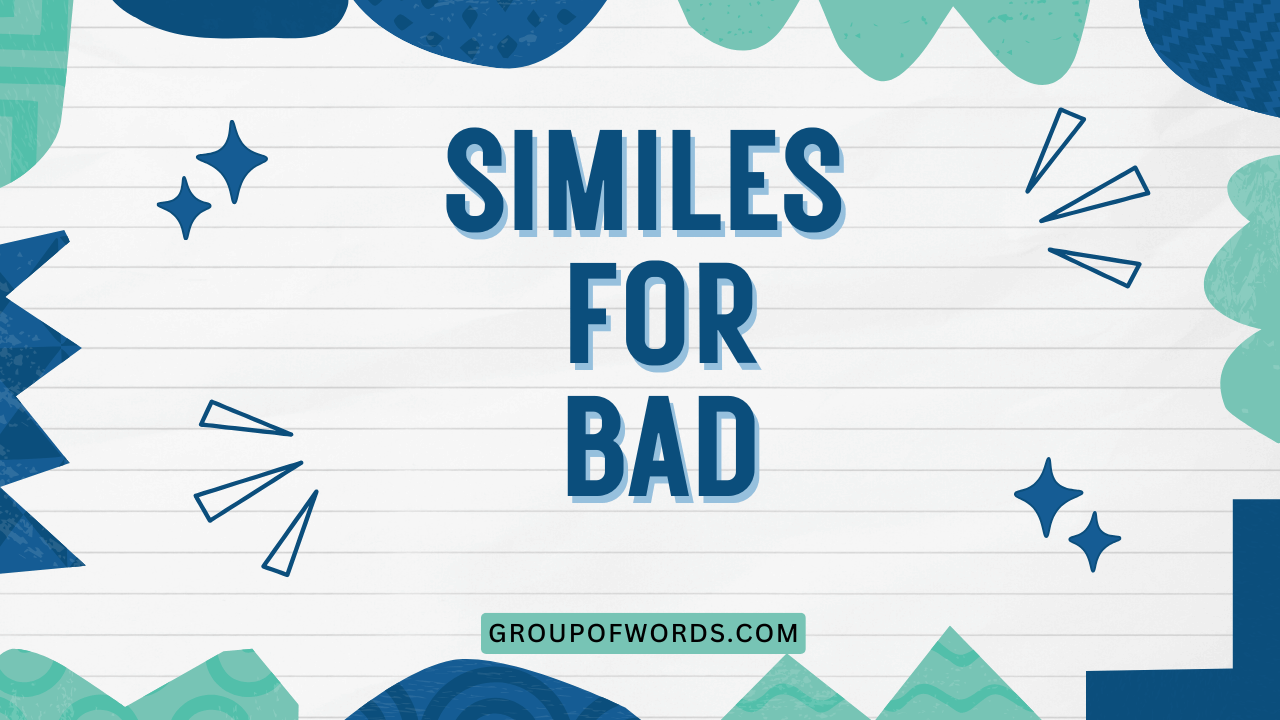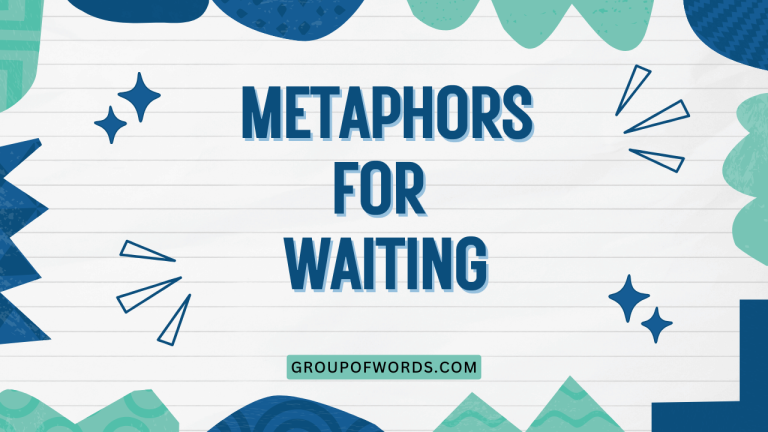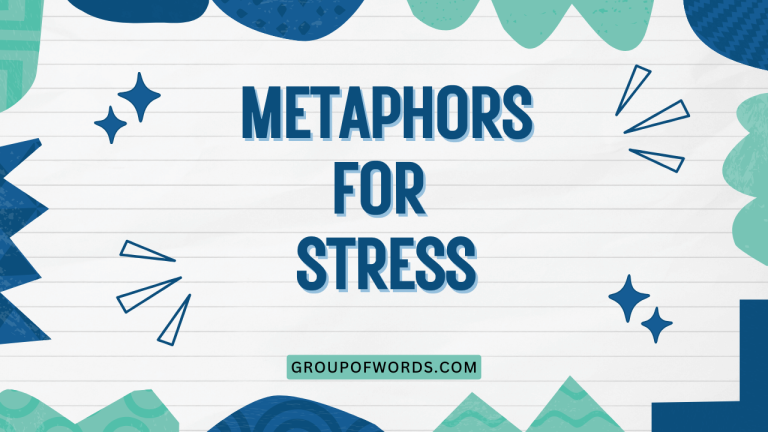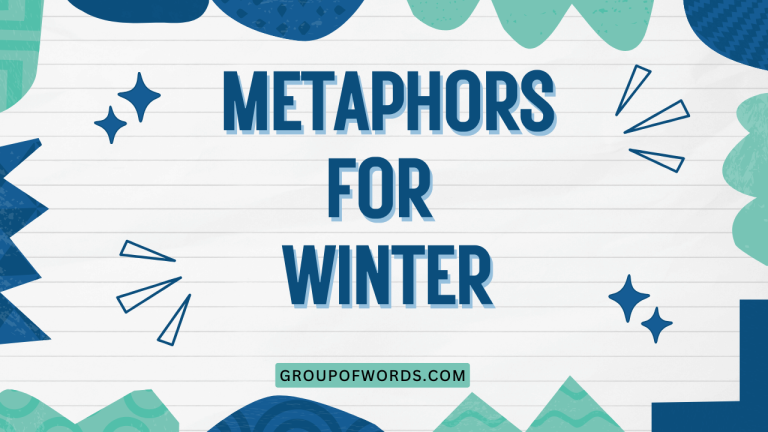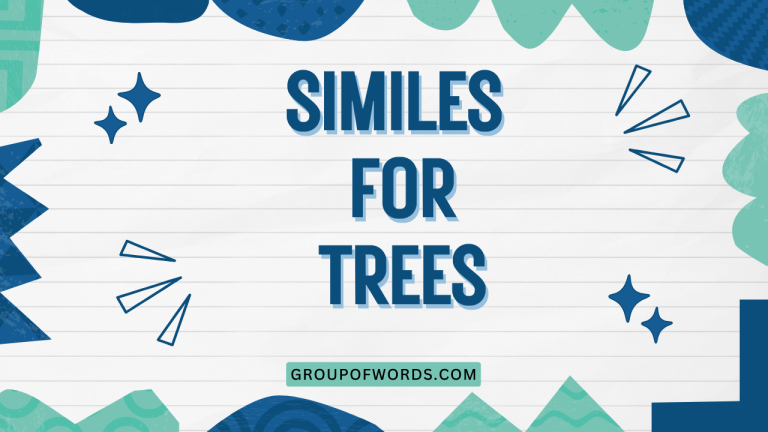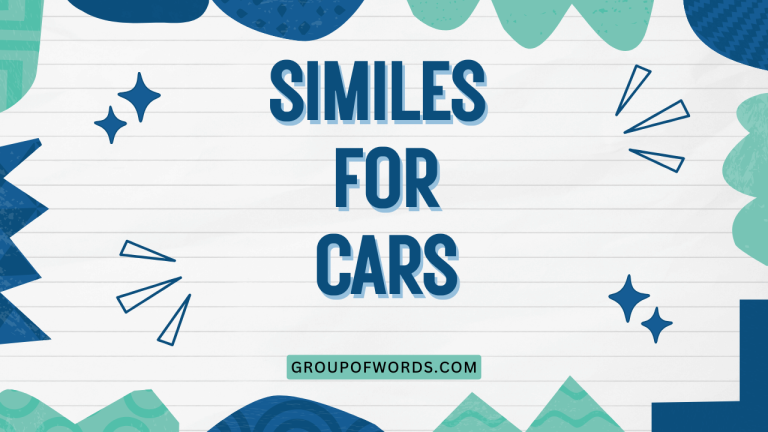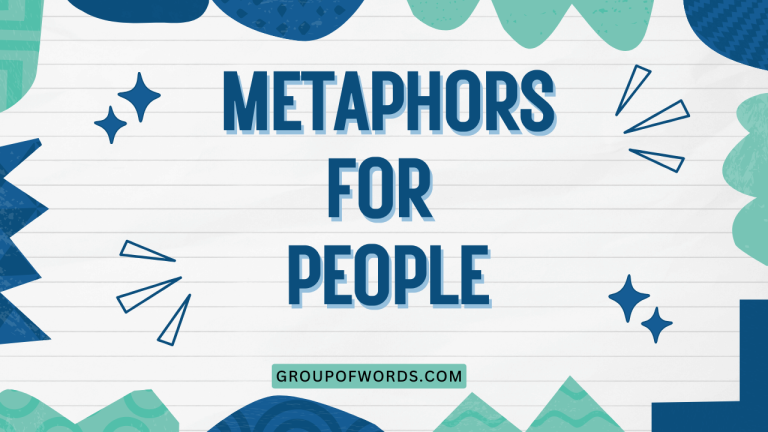Similes for “Bad”: Expanding Your Descriptive Language
Similes are powerful tools in the English language, allowing us to create vivid comparisons and paint memorable pictures with our words. When we want to describe something as “bad,” a simple adjective often falls short.
Similes offer a way to express the degree and nature of the badness in a more engaging and impactful manner. This article explores a wide range of similes that can be used to describe something negative, unpleasant, or undesirable.
Whether you’re a student, writer, or simply someone looking to enrich your vocabulary, understanding and using these similes will enhance your descriptive abilities and make your communication more compelling and nuanced.
This guide is designed for English language learners of all levels, from beginners looking to expand their basic vocabulary to advanced speakers aiming to refine their descriptive skills. We will cover the definition of similes, their structure, various categories of similes for “bad,” usage rules, common mistakes, and practice exercises to help you master the art of using similes effectively.
Table of Contents
- Definition of Similes
- Structural Breakdown of Similes
- Types of Similes for “Bad”
- Examples of Similes for “Bad”
- Usage Rules for Similes
- Common Mistakes When Using Similes
- Practice Exercises
- Advanced Topics: Nuances and Subtleties
- Frequently Asked Questions
- Conclusion
Definition of Similes
A simile is a figure of speech that compares two unlike things using the words “like” or “as.” It’s a way to make a description more vivid and relatable by drawing a connection between something familiar and something less so. Similes are essential for adding color and depth to writing and speech, allowing you to convey emotions, ideas, and sensations in a more impactful way.
Unlike metaphors, which directly equate two things, similes acknowledge the difference between them while highlighting a shared quality.
The primary function of a simile is to enhance understanding and create imagery. By comparing a subject to something familiar, the audience can grasp the subject’s qualities more easily.
For instance, saying “the coffee tasted like mud” is more descriptive and evocative than simply saying “the coffee tasted bad.” The simile evokes a specific sensation of earthiness and unpleasantness.
Similes can be used in various contexts, from formal writing to casual conversation. They are particularly useful in creative writing, poetry, and persuasive arguments, where vivid language can significantly enhance the impact of the message.
Structural Breakdown of Similes
The basic structure of a simile consists of three main components:
- The subject: This is the thing being described or compared.
- The linking word: This is typically “like” or “as,” which establishes the comparison.
- The object of comparison: This is the thing to which the subject is being compared.
The formula can be represented as: Subject + Linking Word + Object of Comparison.
For example, in the simile “His temper was like a volcano,” “his temper” is the subject, “like” is the linking word, and “a volcano” is the object of comparison. This structure effectively conveys the sudden, explosive nature of his temper.
Another example: “The food smelled as bad as rotten eggs.” Here, “the food” is the subject, “as bad as” is the linking phrase, and “rotten eggs” is the object of comparison. This immediately communicates the unpleasant and offensive nature of the food’s smell.
Types of Similes for “Bad”
Similes for “bad” can be categorized based on the specific aspect of negativity they convey. Here are some common types:
Similes Describing Unpleasantness
These similes focus on conveying a general sense of displeasure, discomfort, or disagreeableness. They often relate to senses like taste, smell, or touch.
Similes Describing Harmfulness
These similes emphasize the potential for damage, injury, or danger. They can describe physical or emotional harm.
Similes Describing Ineffectiveness
These similes highlight the lack of desired results or the failure to achieve a specific purpose. They often relate to tools, strategies, or efforts.
Similes Describing Decay or Rot
These similes evoke a sense of deterioration, spoilage, or corruption. They are often used to describe physical objects or moral character.
Similes Describing Worthlessness
These similes emphasize the lack of value, importance, or usefulness. They can describe objects, ideas, or actions.
Similes Describing Evil
These similes are used to portray profound wickedness, depravity, or malice. They often invoke images of darkness, demons, or moral corruption.
Examples of Similes for “Bad”
Here are several examples of similes categorized by the type of negativity they convey:
Examples Describing Unpleasantness
This table contains examples of similes used to describe general unpleasantness. These similes often relate to sensory experiences like taste, smell, or touch, and they aim to create a feeling of discomfort or distaste in the reader.
| Simile | Explanation |
|---|---|
| Tastes like medicine. | Implies a bitter or artificial flavor. |
| Smells like old socks. | Conveys a strong, unpleasant odor. |
| Feels like sandpaper. | Describes a rough, scratchy texture. |
| Sounds like nails on a chalkboard. | Indicates a grating, irritating noise. |
| Looks like a train wreck. | Describes a chaotic and disorganized appearance. |
| As welcome as a skunk at a lawn party. | Indicates extreme unwelcomeness. |
| As fun as root canal. | Describes something extremely unpleasant and painful. |
| Like a slap in the face. | Conveys a shocking and unpleasant surprise. |
| As appealing as a tax audit. | Indicates something completely unappealing. |
| As comfortable as a bed of nails. | Describes something extremely uncomfortable. |
| As refreshing as week-old coffee. | Implies something is stale and not refreshing. |
| As delightful as a dentist appointment. | Indicates something generally dreaded and unpleasant. |
| Like chewing on tin foil. | Describes an unpleasant metallic taste or sensation. |
| As easy as pulling teeth. | Implies something is extremely difficult and unpleasant. |
| As enjoyable as a flat tire. | Indicates something not enjoyable. |
| As soothing as a mosquito bite. | Describes something irritating rather than soothing. |
| Like being stuck in traffic. | Conveys a sense of frustration and annoyance. |
| As pleasant as a visit to the DMV. | Indicates something notoriously unpleasant. |
| Like trying to herd cats. | Describes a task that is frustrating and nearly impossible. |
| As relaxing as a root canal. | Indicates something that is the antithesis of relaxing. |
| As sweet as a lemon. | Implies a sour or unpleasant taste. |
| As smooth as a gravel road. | Describes a rough, bumpy experience. |
Examples Describing Harmfulness
This table illustrates similes used to describe something that is harmful or dangerous. These similes often invoke images of weapons, toxins, or destructive forces to emphasize the potential for damage.
| Simile | Explanation |
|---|---|
| Like a stab in the back. | Indicates a betrayal or act of treachery. |
| As poisonous as venom. | Describes something that is toxic and dangerous. |
| Like a ticking time bomb. | Conveys a sense of impending danger. |
| As destructive as a hurricane. | Describes something that causes widespread devastation. |
| Like walking through a minefield. | Indicates a situation fraught with hidden dangers. |
| As sharp as a razor. | Describes something that is dangerously keen. |
| Like playing with fire. | Conveys a sense of engaging in a risky activity. |
| As damaging as a nuclear blast. | Describes something that causes catastrophic harm. |
| Like a viper in the grass. | Indicates a hidden and deadly threat. |
| As corrosive as acid. | Describes something that eats away at or destroys. |
| Like a disease spreading rapidly. | Conveys the quick and uncontrollable spread of something harmful. |
| As treacherous as thin ice. | Describes a situation that appears safe but is actually dangerous. |
| Like a house of cards. | Indicates something that is unstable and easily destroyed. |
| As fatal as a gunshot wound. | Describes something with deadly consequences. |
| Like a shark in the water. | Conveys a sense of lurking danger and predatory behavior. |
| As volatile as nitroglycerin. | Describes something that is highly unstable and explosive. |
| Like a double-edged sword. | Indicates something with both benefits and dangers. |
| As harmful as second-hand smoke. | Describes a danger that affects even those not directly involved. |
| Like a runaway train. | Conveys a sense of something out of control and heading for disaster. |
| As dangerous as a cornered animal. | Describes someone who is desperate and likely to lash out. |
Examples Describing Ineffectiveness
This table provides similes that describe something as ineffective or useless. These comparisons often involve tools, strategies, or attempts that fail to achieve their intended purpose.
| Simile | Explanation |
|---|---|
| Like banging your head against a brick wall. | Indicates a futile and frustrating effort. |
| As useful as a chocolate teapot. | Describes something completely useless. |
| Like trying to catch smoke. | Conveys the impossibility of achieving something. |
| As effective as a screen door on a submarine. | Describes something completely out of place and ineffective. |
| Like shouting into the wind. | Indicates that your words are having no effect. |
| As helpful as a broken compass. | Describes something that is not only useless but also misleading. |
| Like water off a duck’s back. | Indicates that something has no effect on someone. |
| As practical as a paper umbrella in a hurricane. | Describes something that is completely inadequate for the task. |
| Like flogging a dead horse. | Indicates wasting effort on something that is already over. |
| As successful as a one-legged man in a butt-kicking contest. | Describes someone who is clearly outmatched and doomed to fail. |
| Like trying to nail jelly to a tree. | Conveys the difficulty or impossibility of a task. |
| As relevant as a rotary phone in the age of smartphones. | Describes something outdated and no longer useful. |
| Like trying to teach a pig to sing. | Indicates a futile effort that yields no positive results. |
| As productive as watching paint dry. | Describes a completely unproductive activity. |
| Like rearranging deck chairs on the Titanic. | Indicates making minor changes that will not avert a larger disaster. |
| As convincing as a chocolate fire guard. | Describes something entirely unconvincing. |
| Like chasing rainbows. | Conveys pursuing something unattainable. |
| As stable as a house of cards in an earthquake. | Describes something that will not last. |
| Like swimming upstream. | Conveys fighting a losing battle. |
| As useful as an ashtray on a motorcycle. | Describes something completely useless. |
Examples Describing Decay or Rot
This table presents similes used to describe decay, rot, or deterioration. These comparisons often involve spoiled food, deteriorating structures, or declining health to create a sense of corruption and decline.
| Simile | Explanation |
|---|---|
| Like a corpse left in the sun. | Conveys a sense of putrefaction and decay. |
| As rotten as week-old fish. | Describes something that is extremely spoiled and offensive. |
| Like a building crumbling to dust. | Indicates a gradual process of decay and collapse. |
| As moldy as forgotten bread. | Describes something covered in fungus and unfit for consumption. |
| Like a tooth rotting in your mouth. | Conveys a sense of slow, painful decay. |
| As dilapidated as an abandoned house. | Describes something that is in a state of disrepair. |
| Like a garden choked with weeds. | Indicates that something is being overtaken by undesirable elements. |
| As tainted as poisoned water. | Describes something that has been corrupted or contaminated. |
| Like a relationship gone sour. | Conveys a sense of a connection that has deteriorated over time. |
| As withered as a forgotten flower. | Describes something that has lost its vitality and beauty. |
| Like a dream fading from memory. | Indicates a gradual process of disappearing and being forgotten. |
| As rusty as an old, unused tool. | Describes something that has deteriorated from neglect. |
| Like a promise broken and forgotten. | Conveys a sense of betrayal and decay of trust. |
| As stale as yesterday’s news. | Describes something that is no longer fresh or interesting. |
| Like a secret that festers in the dark. | Indicates a hidden problem that grows worse over time. |
| As fragile as an ancient artifact. | Describes something that is easily damaged or destroyed due to age. |
| Like hope slowly dying. | Conveys a sense of diminishing optimism and eventual despair. |
| As tarnished as an old silver spoon. | Describes something that has lost its luster and appeal. |
| Like a wound that refuses to heal. | Indicates a problem that persists and worsens over time. |
| As hollow as a tree struck by lightning. | Describes something that has lost its inner strength and substance. |
Examples Describing Worthlessness
This table offers similes used to describe something as worthless or insignificant. These comparisons often involve items of little value, insignificant efforts, or wasted resources to emphasize the lack of worth.
| Simile | Explanation |
|---|---|
| Like a drop in the ocean. | Indicates something that is insignificant in the grand scheme of things. |
| As valuable as a blank check. | Describes something that has no inherent value. |
| Like a needle in a haystack. | Conveys the difficulty of finding something of value. |
| As meaningful as a politician’s promise. | Describes something that lacks sincerity and value. |
| Like throwing pearls before swine. | Indicates wasting something of value on those who do not appreciate it. |
| As useful as a lead balloon. | Describes something that is completely useless and impractical. |
| Like chasing after shadows. | Conveys pursuing something illusory and without substance. |
| As important as a grain of sand on the beach. | Describes something that is insignificant and easily overlooked. |
| Like trying to empty the ocean with a spoon. | Indicates a futile and insignificant effort. |
| As relevant as Latin in the modern world. | Describes something that is outdated and no longer applicable. |
| Like a whisper in a hurricane. | Conveys the inaudibility and insignificance of something. |
| As substantial as a house made of straw. | Describes something that lacks durability and value. |
| Like a ghost in the daylight. | Indicates something that is barely perceptible and without substance. |
| As lasting as a footprint in the sand. | Describes something that is temporary and easily erased. |
| Like a broken promise. | Conveys a sense of worthlessness due to unreliability. |
| As significant as a fly on an elephant. | Describes something that is insignificant in comparison to something else. |
| Like a dream that fades at dawn. | Indicates something that quickly disappears and becomes worthless. |
| As essential as a spare wheel on a bicycle. | Describes something that is unnecessary and adds no value. |
| Like trying to hold water in your hands. | Conveys the futility of trying to retain something worthless. |
| As sought after as a torn dollar bill. | Describes something no one wants. |
Examples Describing Evil
This table presents similes used to describe profound evil, wickedness, or malevolence. These comparisons often involve dark imagery, demonic figures, or moral corruption to convey a sense of deep depravity.
| Simile | Explanation |
|---|---|
| Like a devil in disguise. | Indicates someone who appears harmless but is actually evil. |
| As black as sin. | Describes something that is deeply immoral and wicked. |
| Like a serpent in the garden. | Conveys a sense of temptation and corruption. |
| As heartless as a stone. | Describes someone who lacks empathy and compassion. |
| Like a shadow lurking in the darkness. | Indicates a hidden and menacing presence. |
| As cruel as a tyrant. | Describes someone who is brutal and oppressive. |
| Like a spider weaving its web. | Conveys a sense of entrapment and manipulation. |
| As cold as a winter’s night. | Describes someone who is emotionally detached and uncaring. |
| Like a predator stalking its prey. | Indicates a relentless and ruthless pursuit of victims. |
| As corrupt as a fallen angel. | Describes someone who has lost their innocence and become evil. |
| Like a plague spreading across the land. | Conveys the rapid and destructive spread of evil. |
| As twisted as a broken tree. | Describes someone who is morally deformed and perverse. |
| Like a cancer eating away at the soul. | Indicates a gradual and destructive corruption of inner goodness. |
| As soulless as a machine. | Describes someone who lacks humanity and empathy. |
| Like a void that consumes everything. | Conveys a sense of emptiness and destructive power. |
| As deceptive as a mirage. | Describes something that appears appealing but is actually harmful. |
| Like a festering wound. | Indicates a problem that worsens over time and poisons everything around it. |
| As unforgiving as the grave. | Describes someone who is incapable of showing mercy or forgiveness. |
| Like a wolf in sheep’s clothing. | Indicates someone who appears harmless but is actually dangerous. |
| As relentless as the march of time. | Describes an evil that is unstoppable and inevitable. |
Usage Rules for Similes
Using similes effectively requires understanding a few key rules:
- Clarity: The object of comparison should be something that the audience is familiar with. If the comparison is obscure or confusing, the simile will fail to enhance understanding.
- Relevance: The comparison should be relevant to the quality being described. The shared characteristic between the subject and the object should be clear and meaningful.
- Originality: While common similes can be effective, using original and creative comparisons can make your writing more engaging and memorable.
- Context: The simile should be appropriate for the context. A simile that is too humorous or informal may be out of place in a serious or formal setting.
- Avoid Clichés: Steer clear of overused similes (e.g., “as blind as a bat”) that have lost their impact through overuse.
For instance, instead of saying “He was as angry as a bear,” which is a cliché, you could say “He was as angry as a hornet’s nest that had been kicked.” The latter simile is more original and vivid.
Common Mistakes When Using Similes
Here are some common mistakes to avoid when using similes:
| Mistake | Incorrect Example | Correct Example |
|---|---|---|
| Using a metaphor instead of a simile | His anger was a volcano. | His anger was like a volcano. |
| Using an unclear comparison | The problem was like a quibble. | The problem was like a tangled fishing line. |
| Using a cliché | He was as busy as a bee. | He was as busy as a one-armed paper hanger. |
| Using an irrelevant comparison | The car was as fast as a tree. | The car was as fast as a race car. |
The key to avoiding these mistakes is to carefully consider the comparison you are making and ensure that it is clear, relevant, and original.
Practice Exercises
Test your understanding of similes with these practice exercises.
Exercise 1: Complete the Simile
Fill in the blank to complete each simile.
| Question | Answer |
|---|---|
| 1. The coffee tasted like _____. | mud |
| 2. The news hit him like _____. | a ton of bricks |
| 3. The room smelled as bad as _____. | a garbage dump |
| 4. The task was as difficult as _____. | climbing Mount Everest |
| 5. The politician’s promise was as worthless as _____. | a counterfeit coin |
| 6. The old house looked like _____. | a haunted mansion |
| 7. The betrayal felt like _____. | a knife in the back |
| 8. The argument was as pointless as _____. | arguing with a brick wall |
| 9. The food was as appealing as _____. | a plate of worms |
| 10. The experience was as pleasant as _____. | a root canal |
Exercise 2: Identify the Type of Simile
Identify whether each simile describes unpleasantness, harmfulness, ineffectiveness, decay, or worthlessness.
| Simile | Type |
|---|---|
| 1. As poisonous as cyanide. | Harmfulness |
| 2. Like a corpse rotting in the sun. | Decay |
| 3. As useless as a chocolate teapot. | Ineffectiveness |
| 4. Tastes like medicine. | Unpleasantness |
| 5. Like a drop in the ocean. | Worthlessness |
| 6. As helpful as a broken compass. | Ineffectiveness |
| 7. Smelled like old socks. | Unpleasantness |
| 8. Like a building crumbling to dust. | Decay |
| 9. Like a stab in the back. | Harmfulness |
| 10. As valuable as a blank check. | Worthlessness |
Exercise 3: Create Your Own Similes
Create your own similes to describe the following scenarios as “bad.”
| Scenario | Your Simile |
|---|---|
| 1. A poorly written book | Like reading a map in a foreign language. |
| 2. A disappointing movie | As exciting as watching paint dry. |
| 3. A terrible song | Sounds like cats fighting in a dumpster. |
| 4. A failed attempt | Like trying to catch water with a sieve. |
| 5. A corrupt politician | As trustworthy as a fox guarding the henhouse. |
| 6. A toxic relationship | Like walking on eggshells. |
| 7. A boring party | As lively as a graveyard. |
| 8. A difficult test | Like deciphering ancient hieroglyphics. |
| 9. A bad haircut | Looks like a lawnmower attacked my head. |
| 10. An unreliable car | As dependable as a house of cards in a hurricane. |
Advanced Topics: Nuances and Subtleties
For advanced learners, understanding the nuances and subtleties of simile usage can further enhance their descriptive abilities. One advanced technique is to use similes to create irony or satire.
For example, saying “The dictator was as gentle as a lamb” is an ironic simile that highlights the dictator’s cruelty by contrasting it with the image of a gentle lamb.
Another advanced technique is to combine similes with other figures of speech, such as metaphors or personification, to create richer and more complex imagery. For example, “His dreams were like fragile birds, soaring high but destined to be shattered by the harsh winds of reality” combines a simile with personification to create a powerful and evocative image.
Additionally, consider the cultural context when using similes. Some comparisons may be more relevant or understandable to certain audiences than others.
Being aware of these cultural nuances can help you tailor your language to your audience and ensure that your similes are effective.
Frequently Asked Questions
Here are some frequently asked questions about similes:
- What is the difference between a simile and a metaphor?
A simile compares two things using “like” or “as,” while a metaphor directly equates two things without using those words. For example, “He is like a lion” (simile) vs. “He is a lion” (metaphor).
- Can a simile be a cliché?
Yes, if a simile is overused and has lost its impact, it becomes a cliché. Examples include “as blind as a bat” or “as busy as a bee.” It’s best to try to create original comparisons.
- How can I create more original similes?
Think about the specific qualities you want to emphasize and brainstorm objects or scenarios that share those qualities. Try to avoid the first comparisons that come to mind and dig deeper for more unique and unexpected connections.
- Is it okay to mix metaphors and similes?
While it’s generally best to maintain consistency, mixing metaphors and similes can be done effectively if it serves a specific purpose and doesn’t create confusion. However, be cautious and ensure that the combined imagery is coherent.
- Are similes only used in writing?
No, similes are used in both writing and speech. They are a common and effective way to add color and emphasis to everyday conversations.
- How many similes should I use in a piece of writing?
There is no set number. The key is to use similes judiciously and only when they enhance the writing. Overusing similes can make the writing feel forced or artificial.
- Can a simile be extended?
Yes, a simile can be extended by adding more details and elaborating on the comparison. This can create a more vivid and detailed image in the reader’s mind.
- What is the purpose of using simile in writing?
Similes enhance writing by making it more vivid, relatable, and engaging. They help readers visualize and understand concepts by comparing them to familiar things, adding depth and interest to the text and making it more memorable.
Conclusion
Mastering the use of similes, especially those that describe negativity, can significantly enhance your ability to communicate effectively and creatively. By understanding the structure, types, and usage rules of similes, you can paint vivid pictures with your words and convey emotions and ideas in a more impactful way.
Remember to strive for clarity, relevance, and originality in your comparisons, and avoid common mistakes like using clichés or unclear comparisons.
Continue practicing using similes in your writing and speech, and pay attention to how other writers and speakers use them effectively. With practice
, you’ll develop a keen eye for making compelling comparisons and enrich your language skills.
